Adrian
Truly a one-off, Adrian buys fabrics from all over the world and makes them up into shirts, trousers and suits in fantastic gaudy, floral designs.
On the western side of the city centre, the Jordaan is an area of slender canals and narrow streets flanked by an agreeable mix of modest, modern terraces and handsome seventeenth-century canal houses. It was traditionally the home of Amsterdam’s working class, but in recent decades it has become one of the most sought-after residential neighbourhoods in the city. Until the 1970s, the inhabitants were primarily stevedores and factory workers earning a crust in the Scheepvaartsbuurt (Shipping Quarter) that edges the north of the Jordaan. This is now a mixed shopping and residential quarter, while just beyond, the Westerdok is the oldest part of the sprawling complex of artificial islands that today sweeps along the south side of the River IJ.
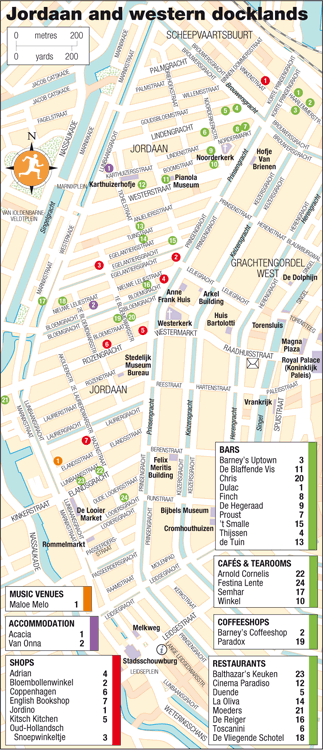
According to dyed-in-the-wool locals, the true Jordaaner is born within earshot of the Westerkerk bells, which means that there are endless arguments as to quite where the district’s southern boundary lies, though at least the other borders are clear – Prinsengracht, Brouwersgracht and Lijnbaansgracht.
The streets just north of Leidsegracht – generally deemed to be the southern border – are routinely modern, but at Elandsgracht 109 you’ll find the enjoyable De Looier antiques market (daily except Fri 11am–5pm). The area’s artery, Rozengracht, slices through the centre, though this wide street lost most of its character when its canal was filled in and is now a busy main road of no particular distinction. It was here, at no. 184, that Rembrandt spent the last ten years of his life in diminished circumstances – a scrolled plaque distinguishes his old home.
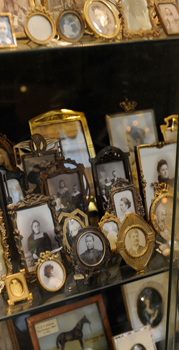
The streets and canals between Rozengracht and Westerstraat form the heart of the Jordaan and hold the district’s prettiest sights. North of Rozengracht, the first canal is the Bloemgracht (Flower Canal), a leafy waterway dotted with houseboats and arched by dinky little bridges, its network of cross-streets sprinkled with cafés, bars and idiosyncratic shops. A narrow cross-street, 2e Egelantiersdwarsstraat – and its continuation 2e Tuindwarsstraat and 2e Anjeliersdwarsstraat – runs north from Bloemgracht flanked by many of the Jordaan’s more fashionable stores and clothing shops, as well as some of its liveliest bars and cafés. At the end is workaday Westerstraat, a busy modern thoroughfare dotted with more mainstream shops.
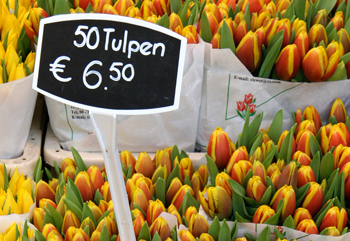
This small but charming museum has a collection of pianolas and automatic music machines dating from the beginning of the twentieth century, fifteen of which have been restored to working order. These machines were the jukeboxes of their day, and the museum has a vast collection of over 15,000 rolls of music, some of which were “recorded” by famous pianists and composers – Gershwin, Debussy, Scott Joplin and others. It also runs a regular programme of pianola music concerts (exact times are on their website).
Hendrik de Keyser’s last creation, finished two years after his death in 1623, this bulky, overbearing brick building represented a radical departure from the conventional church designs of the time, having a symmetrical Greek-cross floor plan, with four equally proportioned arms radiating out from a steepled centre. Uncompromisingly dour, it proclaimed the serious intent of the Calvinists who worshipped here, its central pulpit a complete break with the Catholic past.
The Noordermarkt holds a statue of three figures bound to each other, a tribute to the bloody Jordaanoproer riot of 1934, part of a successful campaign to stop the government cutting unemployment benefit during the Depression. The square hosts some of Amsterdam’s best markets – an antiques and household goods market on Monday mornings (9am–1pm) and the farmers’ market, the Boerenmarkt, on Saturdays (9am–4pm).
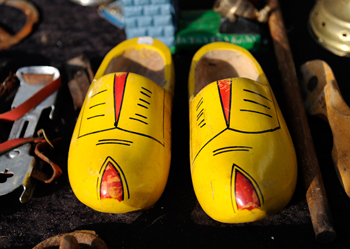
The Lindengracht (“Canal of Limes”) lost its waterway decades ago, and is a fairly nondescript thoroughfare, though home to the Suyckerhofje of 1667 – easy to miss through a mall gateway at no. 94, and with a lovely enclosed garden that is typical of the Jordaan’s many hofjes.
Brouwersgracht marks both the northern edge of the Jordaan and the southern boundary of the Scheepvaartsbuurt – the Shipping Quarter. In the eighteenth and nineteenth centuries, this district boomed from its location between the Brouwersgracht and the Westerdok, a narrow parcel of land dredged out of the River IJ immediately to the north and equipped with docks, warehouses and shipyards. The Westerdok hung on to some of the marine trade until the 1960s, but today industry has to all intents and purposes disappeared and the area is busy reinventing itself, as the old warehouses are turned into bijou studios. The nearby Westerpark provides a spot of green for the locals, and the restored Westergasfabriek some funky places to eat and drink. A five-minute walk away, under the rail tracks and left down Zaanstraat, the 1921 Het Schip housing development is a seminal work of the Amsterdam School and can be visited on hourly tours (Tues–Sun 11am–5pm €7.50).
Truly a one-off, Adrian buys fabrics from all over the world and makes them up into shirts, trousers and suits in fantastic gaudy, floral designs.
Charming little shop selling packets of tulip bulbs in season. Downstairs is a small museum that charts the tulip’s history from the gardens of the Ottoman Empire to becoming Amsterdam’s most iconic flower.
Something of a Jordaan institution, this shop stocks beads and beady accessories – including everything you’ll need to make your own jewellery.
Stocks a well-chosen collection of titles on a wide range of subjects, in particular literature.
Fantastic handmade chocolates and some of the best ice cream in the city.
Crammed full of chunky furniture and brightly coloured bowls and other home and kitchen stuff – you’re bound to find something you think you need here.
Delicious Dutch sweets, piled up in glass jars attracting hordes of kids.
This popular coffeeshop is the most civilized place in town to enjoy a big hit before moving on to Barney’s Uptown across the road for a drink.
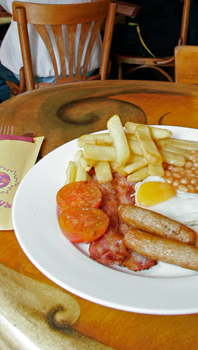
Paradox satisfies the munchies with outstanding natural food, including spectacular fresh fruit concoctions and veggie burgers.
Confectioner and patisserie with a mouth-watering display of pastries and cakes. Take away or eat in the snug tearoom.
Relaxed café-bar with armchairs to laze about on. The outside tables overlooking the canal are a suntrap in the summer.
A small and popular Ethiopian restaurant with an authentic menu of meat, fish and veggie dishes – all mopped up with great East African flatbread. Try the African beer too, served in a calabash and available in a variety of exotic flavours. Large portions, and as much flatbread as you can manage. Mains from around €11.
Queue up along with the rest of Amsterdam for delectable mouthwatering apple-pie –it’s homemade in this agreeable lunchroom-cum-restaurant.
As the name suggests, this restaurant makes you feel like you accidentally stumbled into someone’s kitchen. Their weekly changing three-course menu (€27.50) is very popular. Be sure to book.
Slick place covering all the Italian classics with gusto. It’s in a former moviehouse and very popular, so you may have to shout to be heard. Pasta and pizzas from €12.
Lindengracht 62
![]() 020/420 6692
020/420 6692
Mon–Thurs 5pm–1am, Fri & Sat 4pm–3am, Sun 4pm–1am. Kitchen until 11pm
Busy tapas bar with a tiled interior and a warm and inviting feel. Good food, and there’s also a small venue that hosts flamenco at weekends.
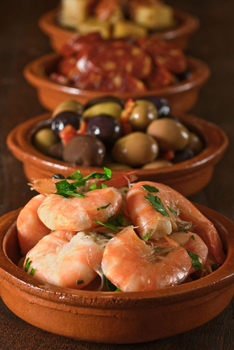
This sleek Jordaan eatery specializes in pinxtos, the delectable Basque snacks-on-sticks that make Spanish bar-hopping such a delight.
Really cosy restaurant just across from the Singelgracht whose theme is obvious the moment you walk in – mothers, photos of thousands of whom plaster the walls. Food is predictably homespun Dutch grub with the odd modern twist, very tasty and reasonably priced.
In the thick of the Jordaan, this is an old-style café filled with modish Amsterdammers. Dinner around €19.
Big, bustling and very authentic Italian restaurant, with great daily specials and an extensive and delicious wine list of regional Italian wines. Excellent service and a nice atmosphere.
Perhaps the pick of the city’s cheap and wholesome vegetarian restaurants, the “Flying Saucer” serves delicious food in large portions. Mains are around €12.
Pleasant, smoker-friendly bar that’s the slick night-time sister of the coffeeshop across the street, with DJs providing a humming backdrop. The American(ish) menu has a good choice of burgers, steaks and sandwiches, and they also specialize in huge breakfasts and weekend brunch.
Somewhat of an institution, this typical neighbourhood bar sits at the corner of the 2e Boomdwarsstraat. Nothing pretentious, but oodles of atmosphere and a well-priced bar menu.
This place is very proud of itself for being the Jordaan’s (and Amsterdam’s) oldest bar –it dates from 1624. The atmosphere is homely and cosy.
An appealing Art Deco grand café housed in what was an old city bank. The metal cage doors remain but now the only money changing hands is at the bar, especially on weekends when it stays open till 3am.
This smart café-lounge bar situated near the Noorderkerk attracts a stylish crowd, who come here to enjoy the design-school ambience, good tunes and superb location. Lunch from noon, dinner from 6pm.
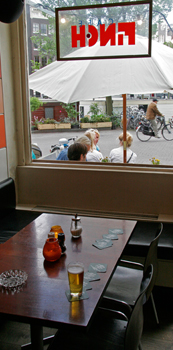
Lovingly maintained brown café with a loyal clientele. The back room is the perfect place to relax with a hot chocolate.
Trendy bar with a laidback Jordaan atmosphere, attracting students and young urban professionals. Reasonably priced bar menu and drinks.
Candle-lit and comfortable, this is one of Amsterdam’s oldest cafés: it opened in 1786 as a tasting house for the (long-gone) gin distillery next door.
An old-time favourite with neighbourhood locals. Nothing fancy, but perfect to linger over coffee or fresh mint tea with a magazine.
The Jordaan has some marvellously unpretentious bars, and this is one of the best: unkempt and always filled with locals.
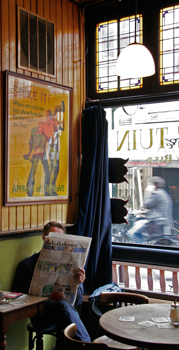
Dark, low-ceilinged bar, with a small back room featuring local blues acts. Jam sessions take place Sunday to Thursday.